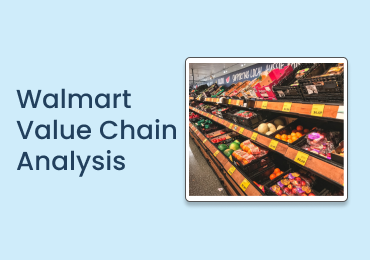Service Industry Value Chain Analysis

1. Introduction
Gaining a competitive advantage over other companies in the market is one of the primary goals of any business. It increases the profit margins, attracts more customers, and strengthens the brand identity. Value chain Analysis is a visual tool to analyze the business activities that can help gain competitive advantage and identify the gaps to improve efficiency and add value for the business. The traditional value chain is structured more around the manufacturing industry rather than the services industry. However, the conventional value chain analysis can still be tweaked to use the value chain concept and come up with its service value chain.
Performing a value chain analysis enables the management to break down company logistics, operations, and infrastructure to reveal the actual value of a product or service. It can also help you identify a competitive advantage you have over rival businesses.
2. Background of Service Industry
The service industry is the industry that delivers services instead of tangible products. The service industry may include banking, hospitality, communication, computer softwares, virtual trade, hospitals, etc. in the last few years, economists are noticing a grand shift of industry from manufacturing to service industry. A main contributing factor to this trend is the fact that most of the work in the manufacturing industry is taken over by machines, so there is less demand for the workforce. While the service industry is still open to explore.
Source: EdrawMax Online3. Primary Activities in Value Chain for Service Industry
According to Porter, companies can use two different ways to increase their profits by using value chain analysis:
Cost leadership: it means cutting costs and streamlining processes to increase profit margin.
Competitive differentiation: Brand yourself as a different company and offer a unique, high-quality service.
Inbound Logistics:
The service value chain consists of different inputs, outputs, and activities from the manufacturing industry. It has the following characteristics.
Inseparability: This type of service is delivered to many consumers simultaneously, for example, an information message.
Intangibility: This type of service is customized for one consumer or a group of consumers, for example, a tennis lesson.
Perishability: Services are not perishable products, so they cannot be saved or stored, e.g., repair service or hotel room.
Heterogeneity: the quality of service and experience might change from person to person, for example, the responsiveness and quality of customer service.
Inbound logistics are defined as how raw materials and supporting supplies are acquired for use in the company. You can see this definition is more suited to the manufacturing industry. However, the supply value chain also covers inbound logistics, but the nature of the products is different. For example, the inbound logistics in the Airbnb model include peer-to-peer listings of accommodation, experiences, and adventures. In their model, the host can fill in their available properties, facilities, and prices on the online portal without any extra cost.
Operations:
The need for operations management might not look very important at first glance in the supply value chain. However, here the operations are the processes that make the services possible and deliver the experiences to consumers. For example, you need food, bedding, drinks, and other necessities well-stocked for quick customer service delivery in the hospitality industry. In tourism, you need to manage transport, boarding, and lodging along with emergency measures.
Outbound Logistics:
Outbound logistics covers the warehousing and distribution of goods in the conventional business model. However, in the service value chain, outbound logistics activities include direct service delivery to the consumer without any intermediate agents or time delays. So, the characteristics here are different. For example, an internet service provider is concerned that the bandwidth, download speed, and quality of service delivered from the company's end are delivered smoothly to the consumer. Similarly, the banking industry's outbound logistics revolve around providing a good customer experience and reliability during transactions.
Marketing and Sales:
Sales in the industry value chain mean convincing your prospective customers to buy your services. While marketing means creating demands by offering the right services to the customers looking for them.
Lead generation is a prime example of marketing and sales in the service value chain. In the traditional industry value chain, you market around your product features. While in the service value chain, you need a different approach to sell your services.
Service:
In the service value chain analysis, it is essential to note that the business's success is mainly dependent on word of mouth and reviews of the customers. Since the products are not physical, the new customers will want to know the experience of other customers. Considering this, after-sale support services are crucial to the success of the services business. A good customer experience means customer loyalty, customer retention, and indirect marketing for the company.
 Source: unsplash.com
Source: unsplash.com
4. Service Industry’ Support Activities
Support activities in the value chain analysis lay a strong foundation for the physical activities to be conducted. This is like a framework that encompasses the primary activities and provides support.
Infrastructure
Infrastructure needs in the value chain for the services industry differ in form and scale for different services businesses. For example, the hotel industry needs an extensive physical infrastructure, including building, bedding, food, and much more. In comparison, IT services companies need data servers, communication channels, fiber optics, etc. Infrastructure also encompasses finances, accounting, planning, and legal wings.
Human Resource Management
Despite the growing role of technology in the service value chain analysis, human resources continue to play a critical role in the value chain for the service industry. Different models of service value chain require different levels of human resource management activities like hiring, training, and facilitating the employees. For example, the Airbnb model has employees who mainly take care of the IT infrastructure. While in the banking industry, the workforce is enormous. There are multiple aspects of HRM like legal proceedings, training the corporate staff, teaching courses, and maintaining the privacy of transactions. So HRM has to invest more effort, time, and resources.
Technology Development
The role of technology has grown exponentially in the last decades. Some of the service value chain industries are based purely on technology advancement. For example, internet services providers, Amazon cloud services, Airbnb; all are success stories of advanced technology. Technology is a critical source of competitive advantage in today's world. Therefore, innovation and research in this segment cannot be ignored.
Procurement
Procurement again differs between different service value chains. In the Airbnb model, procurement is minimal. While in the banking industry, they need to buy supplies for running the business. However, in the hotel industry, procurement is a large-scale activity. End-of-life management is an ongoing challenge in the hotel industry. So, they need to replace equipment and the daily running supplies often. As a result, they must select the best suppliers at a reasonable price to cut extra costs and purchase the
5. Key Takeaways
A value chain analysis can depict the way to profitability for any company. The service value chain analysis aims to align the service industry with the highest standards of customer experience. This is the basic foundation of gaining a competitive advantage for any business. EdrawMax Online is a web-based drawing software that allows the drawing of value chain analysis and over 280+ types of drawings efficiently and accurately. Template Gallery gives you a great start by providing the diagrams' basic structure, which you can customize according to your needs.
6. References
-
Airbnb Value Chain Analysis. Research-Methodology. Published September 16, 2019. Accessed August 27, 2021. https://research-methodology.net/airbnb-value-chain-analysis/
-
Five Procurement Best Practices in the Financial Services Industry. SpendEdge. Published March 15, 2021. Accessed August 27, 2021. https://www.spendedge.com/casestudy/five-procurement-best-practices-for-the-financial-services-industry
-
NetSuite.com. Inbound vs. Outbound Logistics. Oracle NetSuite. Accessed August 27, 2021. https://www.netsuite.com/portal/resource/articles/inventory-management/inbound-outbound-logistics.shtml











